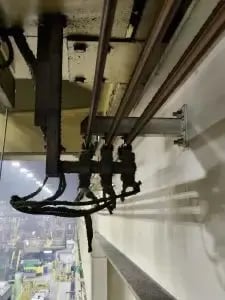-
PRODUCTSreturn
-
SERVICES AND PARTS
-
ABOUT US
Why and when should I add a grounding conductor to my overhead crane?
April 7, 2025
Why and when should I add a grounding conductor to my overhead crane?
5:38
In short…
A grounding conductor has been mandatory on all new overhead crane installations since 2004, due to a change in standards. Overhead cranes installed before this date are not required to have a grounding conductor, because of an acquired right, according to the RBQ. But any electrical modification, and in particular the replacement or addition of an overhead crane on a crane runway, will have to include the addition of the grounding conductor.
Read on to find out more. You can contact us to verify your project using the form at the bottom of the page.
Did you know that the CNESST has recorded “901 accidents and 15 deaths resulting from contact with electric current” involving a machine over the last 5 years? How many of these accidents do you think could have been avoided? Hard to say, but probably a majority.
One measure to reduce the risk of electrification is grounding (injury caused by the passage of an electric current through the body). If your company uses an overhead crane, how do you know if your installation is safe and compliant with current electrical standards?
When I travel around Quebec’s industries to gather information for a project, questions about grounding conductors often come up. As overhead crane replacements or additions account for a significant proportion of Premium’s projects, we have frequently had to answer these questions. But above all, since safety is at the heart of our concerns, we’ve dug deeper into the issue. We’d like to share the available information with you.
In this article, we’ll explain exactly when and why you need to install a grounding conductor on an overhead crane. You’ll discover what regulations apply, and when this upgrade becomes mandatory.
By following these recommendations, you can ensure the safety of your team and avoid costly interruptions to your production.
Let’s start by establishing why grounding is mandatory, and what the standards and regulations are on the subject.
Grounding of overhead cranes: a new standard!
At the end of March 2004, an update to the Canadian Electrical Code (CEC) came into force, including the requirement for grounding. As of this date, new overhead cranes installed in Quebec plants had to be fitted with a grounding conductor. This new regulation also appeared in the CSA B167-08 (4.5.7) standard in 2008.
But what about equipment already installed before that date? Would we be required to install a grounding conductor on all this equipment already in place? No, and here’s why.

Is it necessary to install a grounding conductor on your overhead crane? Here’s how to find out !
According to the RBQ, there is a form of acquired right concerning equipment installed prior to the modification date. In fact, it specifies that “the current Code applies to work currently being carried out. It cannot be used as an overriding criterion for judging the situation regarding work done previously, since the Code of the time was the reference.” (Areas of intervention, different measures and acquired rights, RBQ website)
However, if “modification work is carried out on the portion of the installation concerned, the acquired right is transformed into a duty to comply with the code requirements in effect at the time of the work.” What does this mean? It means that any electrical modification to the existing installation will require the installation of a grounding conductor to bring the installation into compliance with current standards. This is the case when replacing or adding an overhead crane, for example, as the electrical requirements will not be the same.
Other electrical modifications may require the addition of a grounding conductor, if your overhead crane doesn’t already have one. So how do you go about your next project?

Simple steps to ensure compliance and limit inconvenience
- Is it an overhead crane replacement?
- Is it an overhead crane addition??
- Is it a modification affecting an electrical aspect of the lifting system?
- Is there a green conductor bar (or a different color) already in place?

When in doubt, consult a lifting specialist who can analyze the situation in detail. Making a non-compliant modification to a lifting system could have far worse consequences. Being caught out could force you to take emergency action at a time that could further harm your productivity.
In this respect, adding a grounding conductor can be complicated, as the intervention could extend over an entire crane runway, rather than an isolated sector of your production. To limit the inconvenience, your lifting expert can advise you and work with you to determine a method to limit the impact.
We handle modifications to your lifting equipment
Now that you understand the legal obligations and best practices related to overhead crane grounding conductors, you can make the right decisions when it comes to your next modifications. Complying with electrical standards not only avoids fines and interruptions, it also ensures the safety of everyone involved.
If you’re thinking of modifying your overhead crane, we recommend that you have your installation checked by an expert. Contact a Premium specialist for a personalized analysis. We provide support to industrial companies wishing to make compliant and optimized modifications to their lifting equipment. Fill in our form for a personalized assessment of your situation.
Learning Center
Whether you're an expert or know nothing about cranes, you'll find everything you need to know HERE.





